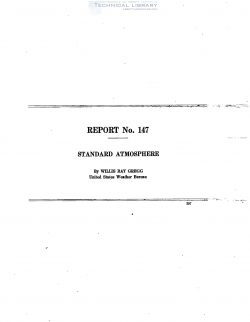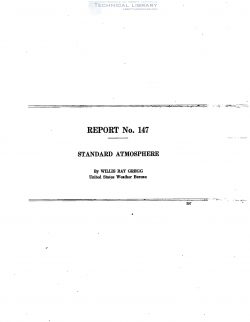naca-report-147

- Version
- 166 Downloads
- 836.13 KB File Size
- 1 File Count
- August 25, 2016 Create Date
- August 25, 2016 Last Updated
National Advisory Committee for Aeronautics, Report - Standard Atmosphere

Upon the recommendation of the subcommittee on aerodynamics at its meeting of December
1 7, 1921, the executive comrhittee of the National Advisory Committee for Aeronautics adopted
for performance testing Toussaint’s formula of temperature decrease with height for obtaining
air density at different altitudes. '
The National Advisory Committee for Aeronautics further requested the United States
Weather Bureau toprepare a‘tech'nical report1 covering the actual observations on the varia—
tion of temperature, pressure, and density of the atmosphere for summer, winter, and the year.
It has been shown from observations over' a long period that up to 10 or 12 kilometers
the mean variation of temperature with altitude in the United States is expressed very closely
by Toussaint’s formula
t= 1.5 — 0.0065Z
where t is the temperature in degrees centigrade and Z the altitude in meters. From 12 to
20 kilometers the temperature is approximately constantat — 55°C. as shown by Table 1 (— 67° F.
in English units, Table 4) in the following report which gives the mean observed values of pres-
sure and temperature at various altitudes for the United States (latitude 40°) for summer,
winter, and mean annual conditions. The values calculated from Toussaint’s formula. are
given in Table 3 (Table 5 in English units) and are in substantial agreement with the observed
mean annual values of Tables 1 and 4. The subcommittee on aerodynamics, therefore, recom-
mended for the sake of uniform practice in difi'erent countries that Toussaint’s formula. be
adopted in determining the standard atmosphere up to 10 ln'lometers {33,000 feet) as given in
Tables 3 and 5. For altitudes higher than 10 kilometers (33,000 feet), values of. pressure and
temperature should be taken from Table 1 or Table 4. In many cases where it is desired to
use values which more closely approximate actual conditions than those obtained by Tons-
saint’s formula, the approximate values (summer or Winter) should be taken from Table 1 or
Table 4.
| File | Action |
|---|---|
| naca-report-147 Standard Atmosphere.pdf | Download |
Comment On This Post